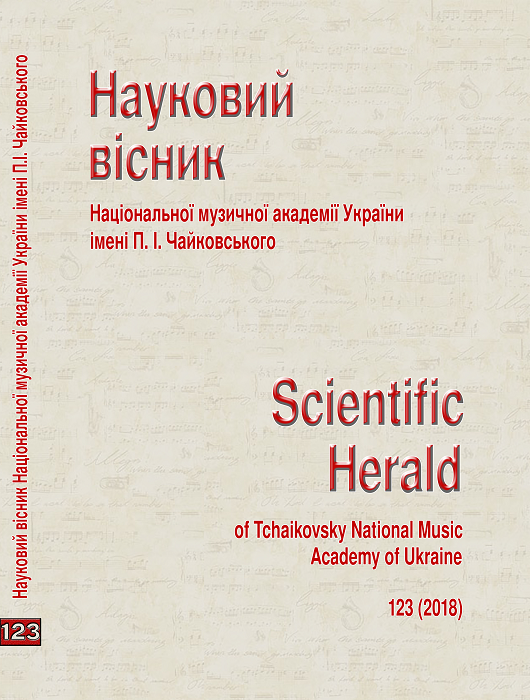About the uniqueness of the timbre-textured organization in the trio of Béla Bartók “Contrasts”
DOI:
https://doi.org/10.31318/2522-4190.2018.123.152425Keywords:
authorship phenomenon, multi-timbre texture, ensemblemusic of the twentieth century, the "Contrasts" trio, program featuresAbstract
Relevance of the study. The subject of research in the article is the relationship of musical software with a different timbre ensemble texture in the chamber instrumental genre of the first half of the twentieth century. Trio B. Bartok for clarinet violin and piano, has been selected for analysis.
Main objective of the study. The aim of the research is to analyze the key parameters of the trio "Contrasts" (genre, form, ideological principles, means of musical expressiveness), as well as the influence of timbre – texture on the implementation of the composer’s program (contrasts) in the musical work, to reveal and state the phenomenon of authorship.
Methodology of the study. The features of Hungarian folk music that have found incarnation in an academic ensemble score. In this perspective also discusses the characteristic features of style verbunkosh features of which are presented in the “Contrasts” of B. Bartok.
Results and conclusions. The stages of the composer’s work on this work are under search. The analysis revealed the following components of software: contrast between the musical embodiment of public and personal, contrasting comparison of clarinet and violin timbres, the contrast between the genre characters of the parts, as well as their main rates. To implement these software components the composer uses different timbres: woodwind (clarinet), string-bow (violin) and stringed percussion (piano).
In terms of implementing the principle of concert, the manifestations are analyzed in the competition of tools implemented in this work. Expressive possibilities of soloing and accompanying instruments are under research, as well as specific performing techniques that help in the implementation of the plan composer.
Studies in the field of musical programming are considered for L. Kazantseva, I. Nesteva and Yu. Khokhlova.
The analysis of each part of the work in the aspect of software features of multi-timbre texture is made, which is also illustrated by musical examples and comments to them. To clarify the style of the Trio of B. Bartok there is a comparative analysis of the fragment of the Hungarian Fantasy by K. Doppler as works on the “Hungarian” theme, with a timbre solution of the texture in B. Bartok’s Trio.
There are three ways of contrasting multi-timbre instruments: alternately holding the melodic line with different instruments, breeding voices in opposite registers, the polyphonic organization of voices according to the principledialogue.
In the conclusions, the interconnection of software with the different timbre composition is stated, in this chamber the instrumental work that demonstrates the for a non-standard artistic solution of textured and timbreorganization of the work.
Downloads
References
Bela Bartok Kontrasty’. Muzyikalnyie sezonyi. URL:https://musicseasons.org/belabartok-kontrasty/Data onovlennya: 17.07.2017 (Accessed 29.07.2018) [in Russian].
Kazanceva, L. Funkcy’y’ programmyi v muzyike. Muzyikal’noe soderzhany’e. Available at: http://www.muzsoderjanie.ru/nauka/nauchnie-publicacii/92-kazantseva-funkcii-v-programme.html (Accessed 1.07.2018). [in Russian].
Nest’ev, Y’. Bela Bartok. Moscow: Muzyika, 1969. 800 p. [in Russian].
Pry’shlyak, A. Strukturni modeli klarnetovy’x trio v trady’ciyi yevropejs’koyi kameralisty’ky’: fortepianni trio z uchastyu klarnetu v XX st.. L’viv, Ukrayina. URL: http://irbis-nbuv.gov.ua/cgibin/irbis_nbuv/cgiirbis_64.exe?C21COM=2&I21DBN=UJRN&P21DBN=UJRN&IMAGE_FILE_ DOWNLOAD=1&Image_file_name=PDF/Nzlnma_2015_34_49.pdf [inUkrainian]
Hohlov, Yu. (1963). O muzyikalnoy programmnosti. Moscow, 144 p. [in Russian]
Holopova, V. (2002). Teoriya muzy’ky’. Sankt-Peterburg, 368 p. [inUkrainian].
Blagodars’ka, O. (2016). Instrumental’ny’j septet: trady’ciyi ta novi tendenciyi / avtoreferat dysertatsii na zdobuttia naukovoho stupenia kandydata mystetstvoznavstva. Saratov [in Ukrainian].
Downloads
Published
How to Cite
Issue
Section
License
Our journal abides by the CREATIVE COMMONS copyright rights and permissions for open access journals.
Authors, who are published in this journal, agree to the following conditions:
The authors reserve the right to authorship of the work and pass the first publication right of this work to the journal under the terms of a Creative Commons Attribution License, which allows others to freely distribute the published research with the obligatory reference to the authors of the original work and the first publication of the work in this journal.
The authors have the right to conclude separate supplement agreements that relate to non-exclusive work distribution in the form in which it has been published by the journal (for example, to upload the work to the online storage of the journal or publish it as part of a monograph), provided that the reference to the first publication of the work in this journal is included.




